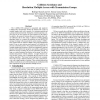Free Online Productivity Tools
i2Speak
i2Symbol
i2OCR
iTex2Img
iWeb2Print
iWeb2Shot
i2Type
iPdf2Split
iPdf2Merge
i2Bopomofo
i2Arabic
i2Style
i2Image
i2PDF
iLatex2Rtf
Sci2ools
144
click to vote
INFOCOM
1997
IEEE
1997
IEEE
Collision Avoidance and Resolution Multiple Access with Transmission Groups
The CARMA-NTG protocol is presented and analyzed. CARMA-NTG dynamically divides the channel into cycles of variable length; each cycle consists of a contention period and a group-transmission period. During the contention period, a station with one or more packets to send competes for the right to be added to the group of stations allowed to transmit data without collisions; this is done using a collision resolution splitting algorithm based on a request-to-send/clear-to-send (RTS/CTS) message exchange with non-persistent carrier sensing. CARMANTG ensures that one station is added to the group transmission period if one or more stations send requests to be added in the previous contention period. The group-transmission period is a variable-length train of packets, which are transmitted by stations that have been added to the group by successfully completing an RTS/CTS message exchange in previous contention periods. As long as a station maintains its position in the group, it is able ...
Collision Resolution | Communications | Contention Periods | Group-transmission Period | INFOCOM 1997 |
Related Content
| Added | 06 Aug 2010 |
| Updated | 06 Aug 2010 |
| Type | Conference |
| Year | 1997 |
| Where | INFOCOM |
| Authors | Rodrigo Garcés, J. J. Garcia-Luna-Aceves |
Comments (0)

